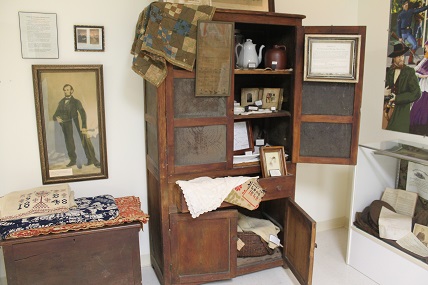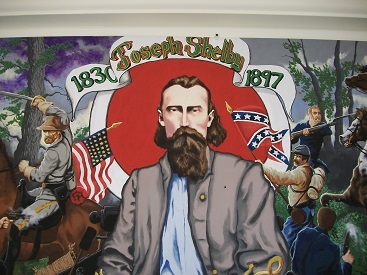The Border War and Civil War in Bates County
By the late 1850s, raiders from Kansas were terrorizing Bates County. John Brown's raid on the Lawrence family farm was uncomfortably close and in January 1859 the Bates County Court ordered Sheriff John Clem to organize a home guard to protect citizens from the mauraders. War came early to the Missouri-Kansas Border and its grip did not lessen until almost one year after the War's end.
General Jim Lane, Doc Jennison, Daniel Anthony and James Montgomery are infamous names in Bates County. These men raided and burned farms and towns. Many Missouri men died at their hands. In 1861, Lane's men burned parts of West Point, Butler and Papinville enroute to Osceola, St. Clair County. By 1862, most Bates County men had chosen the Southern cause because the northern aggression proved to be too much to bear. Partisans, guerrillas, bushwhackers - many local settlers were now labeled by the Federal's as black-flag enemies.
Confederate Colonel Sidney Jackman, Papinville, often served as liason between the Southern army and Bates County men. Bill Turman was the local partisan captain and he played a prominent role in organized harrassment toward the Federals. By the summer of 1862, recently recruited Bates County men fought for the south in the Battle of Lone Jack. Bates Countian, Captain John Newberry of Butler, led the Union Army's Enrolled Missouri Militia. He and his men also fought at the Battle of Lone Jack. Brother against brother. Neighbor against neighbor. It was bloody and brutal.
By the summer of 863 the Federal army grew weary of trying to stop the partisan guerrillas. In July they began arresting female family members of suspected guerrillas. Holding them in a makeshift jail in Kansas City, the building collapsed, both killing and wounding the girls and women. Outrage and fury was the southern response. On August 21st, Quantrill led a raid on Lawrence, Kansas, the center of all the evil that had been perpetrated on the people of western Missouri. Four days later, Union General Thomas Ewing issued Order No. 11, ordering the evacuation of every living soul in Bates County. The counties of Jackson, Cass and Vernon were also included but not all their citizens were effect. Only in Bates was everyone forced to flee. Within 15 days, the Federals burned every farm and town to the ground. Only the chimney's were left. There was no county business officially conducted again until 1866. Only about 30% of the population returned, and those who did owed three years back taxes. Land was sold for unpaid taxes and a new wave of emmigrants settled in. Bates County was forever changed.
The Civil War in Bates County, Missouri
 Every family living in Bates County during the Civil War (1861-1865) has a story. Descendants of these people carry family memories in their hearts. Bates County was Ground Zero for one of the most heinous military orders ever issued against the civilian population. The infamous Order No. 11 forced the depopulation of counties in western Missouri with Bates County being the only one to be completely emptied. Everyone forced to leave. Every town, every farm, almost every building was torched. Bates County lay in the heart of the Burnt District. Union General Thomas Ewing issued the order on August 25, 1863 to exact revenge on Missouri for the frustration the Federals endured in being unable to halt Guerrilla activities and Quantrill's August 21st raid on Lawrence sealed the fate of the people along the Border. Bates County was a no-man's-land. Although attempts to conduct County business were made, for three years there was no official business for the county of Bates. Only about 30% of the population returned and most of those did not come back until the spring of 1866. When they returned, they came home to nothing...except a tax bill. Each returning refugee owed three years back taxes and money was in very short supply. Much of the land was reverted back to the government and sold to eager buyers. Some were looking to own fertile farm land while others were more interested in the rich coal deposits that lay just underground. The cultural fabric of the county was forever changed.
Every family living in Bates County during the Civil War (1861-1865) has a story. Descendants of these people carry family memories in their hearts. Bates County was Ground Zero for one of the most heinous military orders ever issued against the civilian population. The infamous Order No. 11 forced the depopulation of counties in western Missouri with Bates County being the only one to be completely emptied. Everyone forced to leave. Every town, every farm, almost every building was torched. Bates County lay in the heart of the Burnt District. Union General Thomas Ewing issued the order on August 25, 1863 to exact revenge on Missouri for the frustration the Federals endured in being unable to halt Guerrilla activities and Quantrill's August 21st raid on Lawrence sealed the fate of the people along the Border. Bates County was a no-man's-land. Although attempts to conduct County business were made, for three years there was no official business for the county of Bates. Only about 30% of the population returned and most of those did not come back until the spring of 1866. When they returned, they came home to nothing...except a tax bill. Each returning refugee owed three years back taxes and money was in very short supply. Much of the land was reverted back to the government and sold to eager buyers. Some were looking to own fertile farm land while others were more interested in the rich coal deposits that lay just underground. The cultural fabric of the county was forever changed.
Prior to the official declaration of War, Bates County had been in the bullseye of many Kansas men. In 1859 the local court ordered the Sheriff to create a Home Guard to protect the people from the raiding Kansans. Raids back and forth across the Missouri-Kansas border were common. And so it was... Men dragged from their homes in the middle of the night - shot - hung - cabins burned. Riders from Kansas were loathed and feared. Back and forth it went. Kansas jayhawkers and Missouri bushwhackers. Kansas bled and Missouri burned. Civil War was finally declared and the hell on the border began in earnest. Terror escalated. Neighbor turned again neighbor. Suspicion ruled the day. Trusting the wrong person could 'get you dead' in a hurry. The very fabric of civilization was unraveling...
1861-62 were deadly years in Bates County. Kansas Senator & General Jim Lane marched through the county in 1861 and partially burned the towns of West Point, Butler and Papinville. Southerner Sidney Jackman lived just outside Papinville. He joined the Confederate Army (Colonel) and served as a liason to the Partisan Guerrillas in the area. Union man John Newberry became Captain of the Enrolled Missouri Militia in Butler. The Union army occupied Butler and the guerrilla activity kept them busy. In December 1861 a man named Slater was executed, on the west side of the Butler Square, for having a pistol on his person. In May 1862, a Federal foraging party was attacked and men were killed. It's known as the Miami Creek Massacre. The Union army pulled-out of Butler. Many Bates County southern men fought at the Battle of Lone Jack in August and in October 1862 the first battle between African-American soldiers and guerrillas was fought at the Battle of Island Mound.
The Civil War history of Bates County is unlike anywhere else. The people, the places, and the events all are remembered. Their sacrifices are honored. Their stories are told. May we never forget the dark days of the Civil War.

United Confederate Veterans at the Courthouse

Civil War Display in the Timeline Room

General JO Shelby of Shelby's Iron Brigade. General JO Shelby moved to Bates County in 1883.
Shelby was appointed US Marshal of Western Missouri in 1893. He appointed the first African American Deputy Marshal in his office.

Civil War Display in the Timeline Room